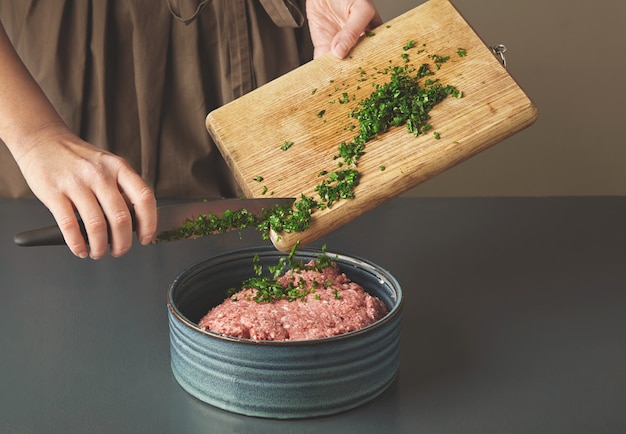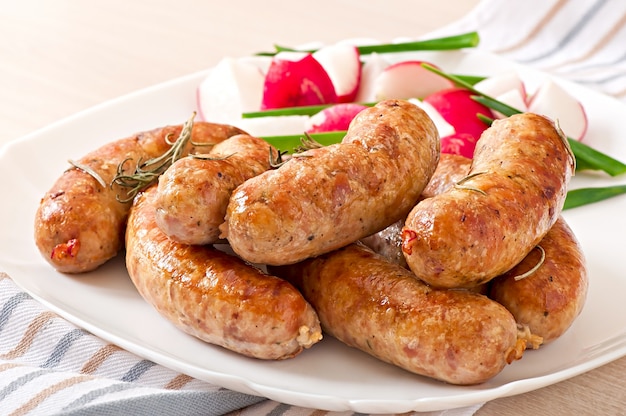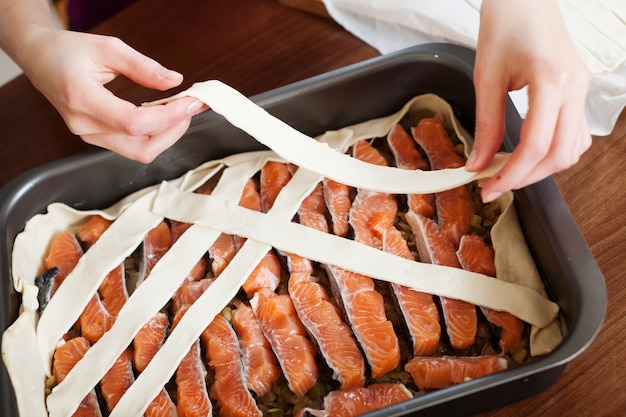Let's face it, there's something undeniably comforting about a perfectly cooked sausage patty. Whether you're craving a hearty breakfast, a satisfying lunch, or a simple weeknight dinner, a crispy, juicy patty hits the spot every time. Over the years, I've experimented with countless recipes and techniques, and I've learned a thing or two about what makes a truly remarkable sausage patty.
So, grab your apron, gather your ingredients, and get ready to embark on a culinary journey to discover the secrets to creating sausage patties that will have you saying, "That's the ticket!"
Part 1: The Sausage - The Foundation of Flavor

The sausage is the heart and soul of your patties, so choosing the right one is crucial. Don't just grab the cheapest pack at the supermarket—take your time and look for good quality sausage with a high meat content.
Fresh vs. Pre-Made: The Sausage Showdown
Now, here's where things get interesting. Do you go for fresh sausage from your local butcher or opt for pre-made patties? It's a personal preference, and both options have their pros and cons.
Fresh Sausage: Fresh sausage offers the ultimate control over flavour and texture. You can choose your spices, adjust the fat content, and even try your hand at making your own sausage. However, forming the patties from fresh sausage requires a bit more effort.
Pre-Made Patties: Pre-made patties are undeniably convenient, often coming pre-seasoned and ready to go. But, you have less control over the ingredients, and sometimes they can be a bit bland or contain too many fillers.
Choosing the Right Sausage: A Guide for the Savvy Patty Maker
No matter which option you choose, here's a checklist to guide your sausage selection:
Fat Content: A good fat content (around 20-25%) is essential for a juicy patty. Too little fat will result in a dry, crumbly patty, while too much fat can make it greasy.
Seasoning: Look for sausage that is well-seasoned, but not overly salty. You want spices that complement the meat, not overpower it.
Texture: The sausage should feel firm and well-textured, not loose or mushy. This ensures your patties hold their shape during cooking.
Making Sausage From Scratch: The Ultimate Control
If you're feeling ambitious (and have a bit of extra time), consider making your own sausage from scratch. It's a rewarding experience that gives you complete control over the ingredients and allows you to create a truly unique flavour profile. Here's a simple recipe to get you started:
Ingredients:
1 kg ground pork
2 tablespoons salt
1 tablespoon black pepper
1 teaspoon garlic powder
1 teaspoon onion powder
1 teaspoon dried sage
?? teaspoon red pepper flakes (adjust to your spice preference)
Instructions:
1. In a large bowl, combine the ground pork and all the seasonings.
2. Mix well with your hands until the ingredients are evenly distributed. Be careful not to overwork the meat, as it can make the sausage tough.
3. Form the mixture into patties, about 1 inch thick.
Part 2: The Patty: Shaping Your Success

Now that you have your sausage, it's time to transform it into delicious patties.
The Art of Patty Formation: Achieving the Perfect Balance
The key to a great patty lies in finding the right balance between density and texture. You want a patty that's firm enough to hold its shape during cooking but not so dense that it becomes tough and chewy.
Here's my approach to forming the perfect patty:
1. Divide and Conquer: Divide your sausage into equal portions, depending on how many patties you want to make. I usually aim for patties that are about 4 ounces each, a good size for a satisfying bite.
2. Gentle Forming: Gently form the sausage into patties using your hands. Don't overwork the meat, as this can make it tough. A light touch is key!
3. Create a Dimple: Using your thumb, create a small dimple in the center of each patty. This little trick helps prevent the center of the patty from bulging during cooking, ensuring even cooking throughout.
The Shape Factor: Round or Square?
The shape of your patty can actually have a surprising impact on its cooking outcome.
Round Patties: Round patties tend to cook more evenly, allowing the heat to distribute throughout the patty uniformly.
Square Patties: While square patties are perfectly fine, round patties often provide a slightly more consistent cooking experience.
Thickness Matters: Finding the Goldilocks Zone
Aim for a patty thickness of about 1 inch. This allows for thorough cooking without drying out the patty. Too thin, and the patties might cook too quickly, resulting in a dry, crispy exterior and a raw center. Too thick, and the interior might not cook through properly.
Part 3: The Cooking: From Stovetop to Oven

Now comes the exciting part - cooking your masterpiece! There are a couple of popular methods for achieving that perfect crispy, juicy patty.
The Stovetop Showdown: A Classic Approach
For years, I've been a loyal advocate of the classic stovetop method. It's straightforward, quick, and gives you excellent control over the cooking process.
Here's what you need for stovetop success:
A cast iron skillet: This is my go-to for sausage patties. Cast iron distributes heat evenly and retains heat well, crucial for creating those coveted crispy edges.
Oil: Choose a neutral oil with a high smoke point, like canola or vegetable oil. These oils won't break down or impart an unwanted flavor during cooking.
Now, here's how to cook your patties to perfection:
1. Heat the Skillet: Heat the oil over medium-high heat. You want the oil shimmering but not smoking.
2. Add the Patties: Carefully add the patties to the skillet, making sure they don't touch each other. Overcrowding the skillet can lead to uneven cooking and steam buildup, which can make the patties soggy.
3. Cook for 3-4 Minutes per Side: Cook the patties until they're golden brown and crispy on the bottom. Resist the urge to flip them too early—patience is key for achieving that perfect crust.
4. Reduce the Heat: Reduce the heat to medium and continue cooking for another 2-3 minutes per side, or until the internal temperature reaches 160°F (71°C). Use a meat thermometer to ensure the patties are cooked through.
5. Rest: Allow the patties to rest for a few minutes before serving. This allows the juices to redistribute throughout the patty, resulting in a more flavorful and juicy bite.
The Oven Alternative: A Hands-Off Approach
For those who prefer a more hands-off approach, the oven provides a convenient alternative.
Here's what you'll need:
A Baking Sheet: Use a baking sheet lined with parchment paper or foil. This will prevent the patties from sticking to the sheet and make for easier cleanup.
Oven: Preheat your oven to 400°F (200°C).
Now, follow these steps for perfectly oven-baked patties:
1. Arrange the Patties: Place the patties on the baking sheet, ensuring they don't touch each other.
2. Bake: Bake for 15-20 minutes, or until the internal temperature reaches 160°F (71°C). Again, a meat thermometer is your best friend for ensuring proper cooking.
Part 4: The Finishing Touches: Elevating Your Patties
We're almost there! Now, let's add those finishing touches that transform a good sausage patty into an exceptional one.
Adding a Touch of Flavor: Glazes, Spices, and More
Glaze: During the last few minutes of cooking, brush your patties with a sweet and smoky glaze. My go-to is a simple mixture of maple syrup, brown sugar, and smoked paprika. You can also experiment with other glazes like bbq sauce or teriyaki.
Spices: Sprinkle on a little extra seasoning like smoked paprika, chili powder, or garlic powder to enhance the flavor. A touch of cayenne pepper can add a subtle kick.
Mustard: A smear of mustard on the patties before cooking adds a touch of tanginess and helps create a beautiful, crispy crust.
The Importance of Rest: A Crucial Step
Allow those patties to rest for a few minutes before serving. This allows the juices to redistribute, resulting in a more flavorful and juicy patty. Be patient—those few minutes make a world of difference!
Part 5: The Perfect Accompaniments: Pairing Your Patties with Delight
Sausage patties are incredibly versatile and pair well with a variety of sides and toppings. Here are some of my personal favorites:
Breakfast: Eggs, hash browns, toast, pancakes, and grits are all classic breakfast companions for sausage patties. A simple breakfast sandwich with a fried egg, cheese, and a little ketchup is always a winner.
Lunch: Pair your patties with a side salad, a dollop of sour cream, or some crispy fries for a satisfying lunch. Add a splash of BBQ sauce for an extra punch of flavor.
Dinner: Sausage patties are great with mashed potatoes, gravy, and roasted vegetables for a hearty and comforting dinner. Consider adding a touch of apple cider vinegar to your gravy for a hint of tanginess.
Part 6: Serving Suggestions: From Classic to Gourmet
The beauty of sausage patties is that they can be dressed up or down depending on the occasion. Here are a few ideas to inspire your next patty-based meal:
Classic Breakfast Sandwich: Layer a crispy sausage patty on a toasted english muffin with a fried egg, cheese, and a little bit of ketchup. Add a few slices of tomato and spinach for a healthier twist.
Gourmet Brunch: Elevate your sausage patties with a drizzle of maple syrup, a sprinkle of chopped pecans, and a side of fresh fruit for a delightful brunch experience.
Hearty Dinner: Serve your patties with a side of creamy mashed potatoes, rich gravy, and roasted brussels sprouts for a satisfying meal. Consider adding a side of cranberry sauce for a festive touch.
Part 7: Troubleshooting: Fixing Common Patty Problems
No one is perfect, and sometimes things don't go as planned in the kitchen. Here are some common problems you might encounter while making sausage patties and how to fix them:
Problem: Dry Patties
Solution: Use sausage with a higher fat content. You can also add a tablespoon of butter or olive oil to the skillet before cooking. Avoid overcooking the patties.
Problem: Greasy Patties
Solution: Use sausage with a lower fat content. Drain the excess grease from the skillet during cooking by placing the patties on a wire rack over a baking sheet or using paper towels to blot the grease.
Problem: Burnt Patties
Solution: Reduce the heat. Don't overcrowd the skillet. Make sure to keep a close eye on the patties, especially if they are very thin.
Problem: Raw Patties
Solution: Cook the patties for a longer time. Use a meat thermometer to check the internal temperature. It's always better to err on the side of caution and cook a bit longer than you think necessary.
Part 8: FAQs: Answering Your Burning Patty Questions
Why Are My Sausage Patties So Dry?
Dry patties are usually a result of using sausage with too low a fat content or overcooking. Add more fat to the sausage or cook it for a shorter time to prevent dryness. You can also try covering the skillet with a lid for a few minutes during cooking to help trap steam and prevent moisture loss.
What's the Best Way to Store Leftovers?
Store leftover patties in an airtight container in the refrigerator for up to 3 days. You can also freeze them for up to 3 months. To reheat frozen patties, simply place them in the oven at 350°F (175°C) for 15-20 minutes, or until heated through.
Can I Use ground beef Instead of Sausage?
Absolutely! Use ground beef with a higher fat content (around 80/20) for juicier patties. You may need to adjust the seasoning to your taste. Experiment with different spices and herbs to find your perfect combination.
How Can I Make My Sausage Patties More Flavorful?
Add a glaze, spices, or mustard to your patties before cooking. You can also try adding chopped onions, peppers, or garlic to the sausage mixture. Adding a little bit of fresh herbs like rosemary or thyme can elevate the flavor.
What are Some Other Ways to Cook Sausage Patties?
Besides stovetop and oven, you can also cook sausage patties in a pan fryer, air fryer, or even on the grill. Experiment with different cooking methods to find your favorite. An air fryer is a great option for achieving a crispy exterior without the added fat.
Part 9: Conclusion: Mastering the Art of the Sausage Patty
There you have it, my ultimate guide to creating crispy, delicious sausage patties. Remember, the key is to use good quality sausage, form the patties properly, cook them thoroughly, and add a touch of flavor to your liking. With a little practice and these tips, you'll be creating mouth-watering sausage patties that will have you craving more.
Now go forth, experiment, and enjoy the delicious results!
Everyone is watching

Corn on the Cob: The Ultimate Guide to Perfectly Cooked Ears
Healthy MealsAh, corn on the cob. Just the name evokes images of sunny days, barbecues, and that sweet, juicy flavour that ...

Perfect Pork Roast Oven Cooking Time: A Guide to Delicious Results
Healthy MealsThere's something truly satisfying about a perfectly roasted pork. The aroma alone is enough to make your mout...

Ham Cooking Time: How Long to Bake, Smoke, or Boil a Delicious Ham
Healthy MealsAh, ham. It's a classic, isn't it? A real crowd-pleaser, especially around holidays. And when done right, it'...

Scallops: The Ultimate Guide to Perfect Cooking
Healthy MealsAh, scallops. Those delicate, sweet, and utterly delicious morsels of the sea. They hold a special place in my...

Spaghetti Squash: The Ultimate Guide to Cooking and Serving
Healthy MealsRemember that time you saw spaghetti squash at the supermarket, looking all bumpy and strange, and thought, "W...
